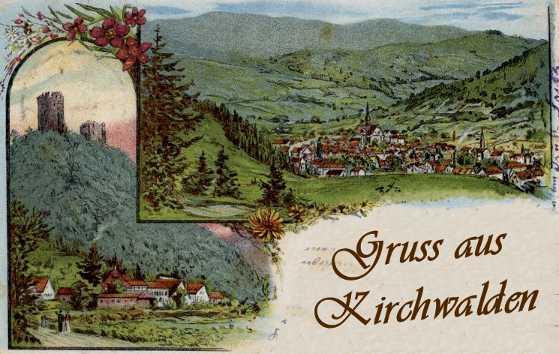Kirchwalden - SANDRA SCHWAB | Historical Romance Author
Main menu:
- Welcome
-
Bookshelf
- Eagle's Honor
- Allan's Miscellany
- A Love for Every Season
- Stand-alone Novels
- About Sandra
- Research
- Author Services
- Contact
- Blog
Kirchwalden
The picturesque little town of Kirchwalden in Castle of the Wolf is based on the town of Waldkirch, where my family used to live when I was still little. It is surrounded by fields, meadows and woods -- the ideal playground for a child! In the late 19th century Waldkirch became famous for organ building. Examples of this art can be found in the Elztalmuseum, next to the beautiful Baroque church of St. Margarethen, which you can see in the picture to the left. This is the church Cissy admires when she arrives in Kirchwalden:
She turned and stared in wonder at the church, so unlike the ancient grey village church at home, which huddled against the ground as of to seek shelter from the cold winds which blew from the moor. This church rose proudly from the ground, with the belltower pointing to the nightly sky like a slender finger. And even amidst the falling snow, the building seemed to shine, all done in white and red, with elegant, sweeping curves and the hint of gold on the tops of the roof. And in dark niches along the front, saints of stone stood guard over the entrance.
The building of the Elztalmuseum, which now houses barrel and fairground organs, used to be a convent which belonged to the church. However, when Baden came under Napoleon's rule, the convent was dissolved. By the mid-19th century the building had been transformed into an inn. In 1882 Charles Wood, author of In the Black Forest, described Waldkirch thus:
". . . we entered the straggling, beauitfully situated town of Waldkirch, surrounded by romantic hills and heights, forest-crowned, ruin-crowned. On all sides were wooded slopes and grand undulations, which make Waldkirch one of the most picturesque spots in the Black Forest.
Under the shadow of one of the hills there stood the hotel and pension of St. Margherita. I had meant to push on that night by train to Freiburg; but falling in love with the situation of the house, with the house itself, with the romantic beauty of Waldkirch and its whole surroundings, it was impossible to leave so many attractions. . . . . The house itself had much to do with this remaining. A large, rambling building, with great rooms, and immense corridors, and wide, old, carved staircases. Ages ago it had been a nunnery. Year after year, age after age, nuns had walkes these corridors like spectres from another world: and, silently, like spectres, must have stolen across to the quaint old church adjoining. Or perhaps -- who knows? -- there may have been an underground passage connecting the nunnery with the sacred edifice.
The very sensation of sleeping in this wonderful old house was almost enough to bring one to Waldkirch: certainly enough to detain one when there. And when darkness had fallen, the gream gloomy corridors were peopled with a whole army of nuns; from every doorway seemed to issue a veiled and hooded figure.
But modern innovations had crept in. Gardens and vineyards, and lovely children playing about, making the old place ring again with their happy, careless laughter."
